After the split verdicts in Iowa and New Hampshire, it's looking more and more likely that Super Tuesday will be meaningful. If Clinton wins South Carolina, Obama is probably on his last legs. There's always the possibility of some unexpected scandal or development that puts one of the frontrunners out of the race. More likely, however, we are going to be on knife's edge for some time to come, particuarly if Obama wins Nevada, at which point both a South Carolina win and an extraordinarily competitive Super Tuesday seem like foregone conclusions.
Most of the focus so far has been on California, but only 22% of the delegates to be won on February 5th will come from that state. Before we get to the fun stuff, let me run through a couple of caveats and assumptions:
- I am assuming that the race is likely to tighten. Right now, the Hillary's national margin over Barack Obama is roughly 10 points, plus or minus 5 depending on which poll you prefer. If Obama is not able to chip away at that margin before February 5th, the outcome will likely be decisive enough for Hillary to cinch the nomination for her. While Obama would still stand to win around five states if the election were held today (Illinois, Georgia, Alabama, and some of the smaller caucus states), Hillary would likely hold a large enough advantage in both delegates and narrative/momentum that there would be pressure on Obama to drop from the race. However, I believe that the race is more likely than not to tighten. Obama's probable victory in South Carolina and possible victory in Nevada are likely to be worth something, and primary races tend to tighten anyway when there are multiple viable candidates, as we saw in Iowa and New Hampshire.
- I'm assuming that John Edwards remains in the race. This seems like the only fair assumption to make at this stage. However, my best guess is that he will only have an impact in a minority of states. I know there have been some good polling results for Edwards here and there, but he's now below 15 percent in all major national polls (this 15 percent threshold is particularly significant, as I'll explain in a moment), and I think it will take a surprise result in Nevada or South Carolina to give him enough momentum to reverse that trend. If you don't like this result, keep in mind that it's just my opinion, and get out there and work/donate for your candidate!
- I'm projecting delegates, not raw voting totals. One thing I significantly underplayed in last week's edition is that Democratic primaries and caucuses are not winner-take-all. In fact, Democratic rules prohibit winner-take-all primaries (Republican rules allow them). This means that we shouldn't look at primaries in the same way that we look at Senate or General Election matchups; the margin of victory matters. Thus, I'm going to take a leap of faith and actually try and project the delegate totals, rather than listing states as "lean Obama", "lean Clinton", etc.
- Beware the 15% viability threshold. The one complication the delegate math introduces is the 15% viability threshold. The way that Democratic delegates are assigned is as follows:
Roughly 2/3 of delegates are assigned at the Congressional District (CD) level. These delegates are assigned proportionately -- subject to a 15% viability threshold. So if in CA-5 the voting is Clinton 50, Obama 36, Edwards 14, Edwards is not eligible for any delegates from that district; he did not meet the 15 percent threshold.
The other 1/3 of delegates are assigned at the statewide level. Once again, these delegates are assigned proportionately, and once again they are subject to a 15% viability threshold based on the statewide results. A candidate can get district-level delegates if he polls below 15% statewide -- provided that he polls at better than 15% in those CD's. (For example, Al Sharpton picked up 8 New York delegates in 2004 even though he polled at just 8% statewide; those delegates came from urban CD's in New York City). But he cannot get any state-level delegates.
This means that candidates polling below 15 percent statewide will get at best a handful of delegates, and quite frequently, no delegates at all. So if you're wondering why I'm giving John Edwards just 2% of the delegates in California, this is why.
- This is art, not science. These are simply my best educated guesses about the results; I've thought about them carefully, but there is no super-secret formula or anything like that. I hope you'll find the data useful even if you disagree with the projections I've made.
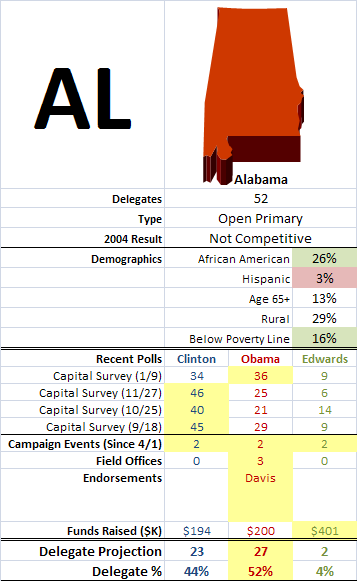
I had been putting this in Obama's column before, and now we have a poll confirming that he's ahead, although it's within the margin of error. Obama's been working the ground in Alabama for awhile now, and between that any continued shift of black votes toward him, I'd expect that margin to grow. Projected Delegate Count: Obama 27 (52%), Clinton 23 (44%), Edwards 2 (4%).

I'm projecting most of these small caucus states as narrow wins for Obama, where he's generally been on the ground longer than Hillary and also outfundraised her. Alaska, a very young, very male state whose Democratic base can be idiosyncratic and progressive (Kucinich did very well here in 2004), is no exception. Projected Delegate Count: Obama 7 (54%), Clinton 5 (38%), Edwards 1 (8%).
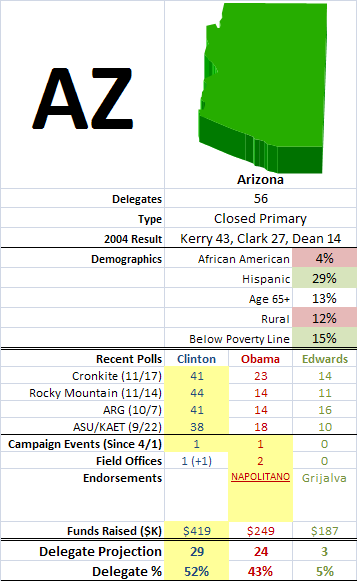
In spite of Janet Napolitano's endorsement, I still see structural advantages for Clinton in this state -- it's a closed primary, and Obama hasn't made many inroads with Hispanics. Hillary also did especially well in the last couple of (pre-IA, pre-NH) polls, although Obama had been more competitive at points earlier in 2007. Projected Delegate Count: Clinton 29 (52%), Obama 24 (43%), Edwards 3 (5%).
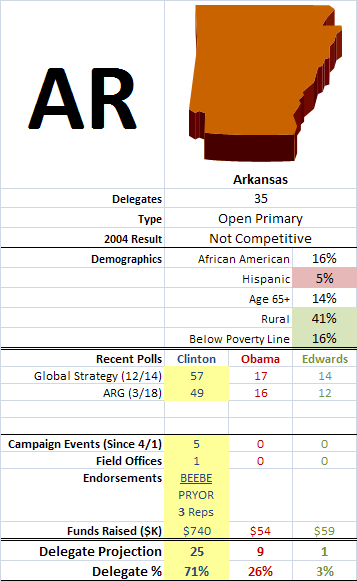
Since delegate counts are not winner-take-all, these states do matter to a certain extent, although Obama has made no pretense of competing here. The decently-sized African American population and open primary status should be enough to guarantee him viability in most CD's, but not much beyond that. Projected Delegate Count: Clinton 25 (71%), Obama 9 (26%), Edwards 1 (3%).
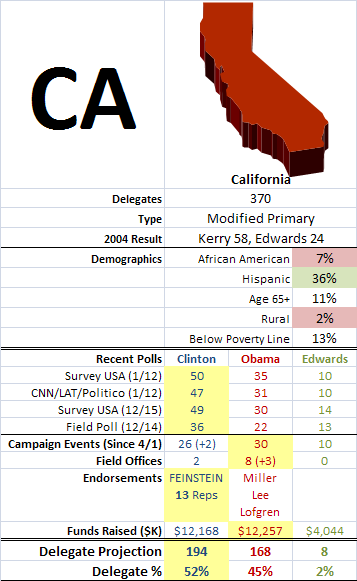
There are two important structural factors in this state, one of which favors Clinton and the other Obama. For Obama, the good news is that independents in California can vote in the Democratic primary but NOT in the Republican primary. That was also the case in 2004, although since the contest in California was not nearly as competitive in 2004 as it will be this year, pollsters may not have a very good grasp on what percentage of independent voters we should expect. Survey USA, for example, expects just 13% of voters will be independent; if you increase that number to 25% then Clinton's lead is cut from 15 points to 11.
The good news for Clinton is that around half of Californians vote by mail rather than at their precinct, and some of those votes are already coming in now. Thus, to the extent that that the race moves toward Obama late, some of the votes he might have won will already be off the table. (The Obama folks have argued that it tends to be wealthier independent voters who vote by mail, a group which tends to like him, but we shall see).
Anyway, you can see the new polls. I have no particular reason to doubt those numbers, although the Survey USA polls have always tended to favor Clinton, and there's no trendline in the CNN poll. We should get a number of new surveys soon, including the much-anticipated Field Poll, which showed closure for Obama back in December. I expect the margin to narrow, but we have to project the state for Clinton at this point. The big question: can Obama find a way to make inroads with Hispanic voters, who favored Clinton 63-26 in the Survey USA data? Projected Delegate Count: Clinton 194 (52%), Obama 168 (45%), Edwards 8 (2%).
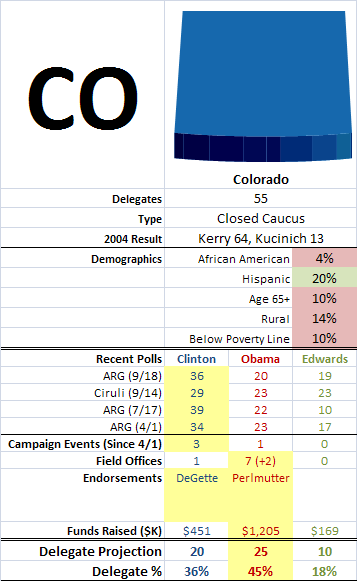
Obama is going all-out in Colorado, with 7 (!) field offices. The other metrics look good for him too, particuarly the fundraising numbers. I suspect this effort will probably be successful, but the question is: Why Colorado?
I think the reason has to do with media narrative. It's not clear how the media is going to anoint a winner on Super Tuesday. Is it by the delegate counts? The number of states won? The popular vote? Who performs best relative to expectations? One thing a lot of people are going to look at to break the tie are the results in California. But California appears to be polling about 5 points more favorably for Clinton than the national numbers, and so one possibility is that Clinton wins California, even if Obama has a pretty good night overall.
So Obama needs to develop a February 6th narrative that counters the California story -- and one pretty good one is that he's the electable guy who can carry the purple states. There aren't a lot of purple states on Super Tuesday, but the two most prominent exceptions are Colorado and Missouri -- two states where Obama is invested heavily. Expect Obama to continue to engage in these states, and if he wins them, for his campaign to spend a lot of time talking about how these results validate Iowa, how he can run a 50-state campaign, etc. Projected Delegate Count: Obama 25 (45%), Clinton 20 (36%), Edwards 10 (18%).
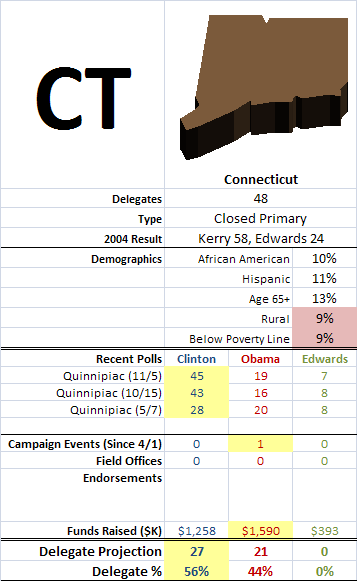
Not reflected here is the endorsement of Ned Lamont, and the metrics look better for Obama than you'd think at first glance, especially the fundraising numbers and the wealthy, urban population base. Still, I'd expect the results here to fall roughly along Yankees-Red Sox lines, with Clinton winning the area west of the Connecticut River, and Obama winning the east. Since the western portion of the state is more populated, that dynamic favors Clinton. Projected Delegate Count: Clinton 27 (56%), Obama 21 (44%).

I'd called this a solid Clinton state before, and she just picked up the endorsement of Governor Minner. However, Delware has a significantly larger African-American population than I'd realized, and a new poll in neigboring Maryland shows Obama with a fairly substantial 39-26 lead. So this may pretty much be a toss-up, although I'm keeping it in Clinton's column for now. Projected Delegate Count: Clinton 8 (53%), Obama 7 (47%).

Obama has polled strongly all year in Georgia, including a 3-point lead in a new Mason Dixon poll. Georgia is also the most urban of the Southern states, and Obama recently picked up the endorsement of Atlanta Mayor Shirley Franklin. He should win the plurality of delegates here. I'm also giving a few to John Edwards, who ran strongly here in 2004, although the Insider Advantage poll that had him at 33 percent a few weeks back is starting to look like an outlier. Projected Delegate Count: Obama 40 (46%), Clinton 33 (38%), Edwards 14 (16%).
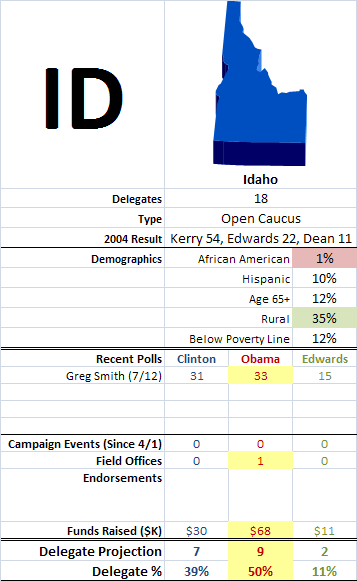
Obama's metrics are strong across the board, reflecting the pattern where he remains more orgnaized in the small caucus states. Projected Delegate Count: Obama 9 (50%), Clinton 7 (39%), Edwards 2 (11%).
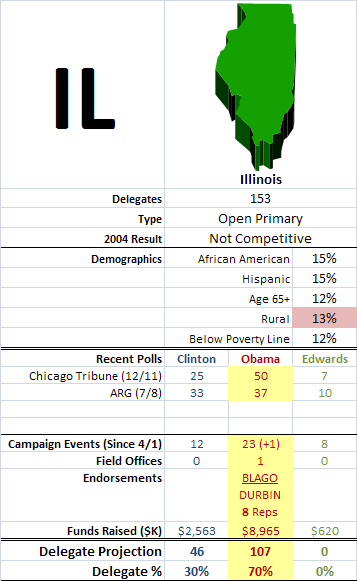
Obama had a 25-point lead in the Chicago Tribune poll, and that was before Iowa and New Hampshire. Clinton is not engaged in the state and Illinois may compete against Arkansas for having the widest margin of victory on election day. Obama may even shut Clinton out of viability in a few Chicago CD's. Projected Delegate Count: Obama 107 (70%), Clinton 46 (30%).
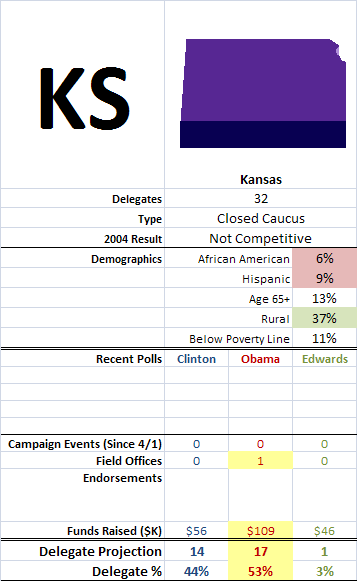
The metrics are essentially the same as in Idaho, and if Obama invests heavily in Missouri, he may also get some cross-over effect in the Kansas City suburbs. Also, his mother is from this state. Projected Delegate Count: Obama 17 (53%), Clinton 14 (44%), Edwards 1 (3%).
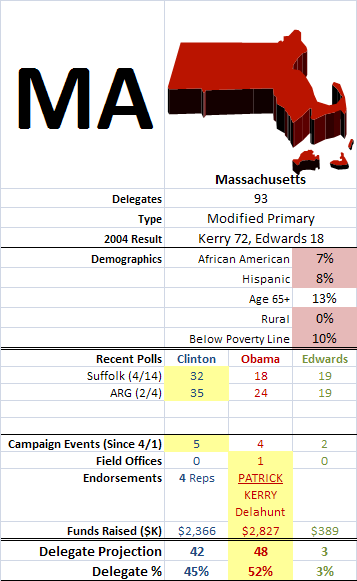
Massachusetts is one of the only states where Chris Bowers and I disagreed last time around; I described it as solid Obama, whereas he put it as leans Clinton. In light of John Kerry's endorsement (and an absence of polling data), I'm going to continue to respectfully disagree with him. Obama raised substantially more in Massachusetts, is the only one with a field office here, and has the rare Governor-Senator endorsement double play. This should be one of his better states. Projected Delegate Count: Obama 48 (52%), Clinton 42 (45%), Edwards 3 (3%).
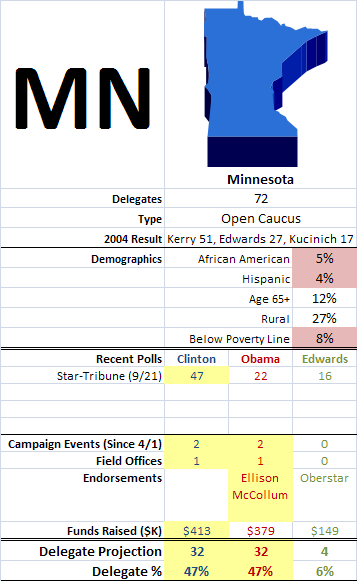
I'm surprised there hasn't been more noise coming out of Minnesota; it's one of the larger, potentially more competitive Super Tuesday states. Until we see some new polling numbers or an Amy Klobuchar endorsement, I'm going to continue to call this one a toss-up and split the delegates 50:50. Projected Delegate Count: Clinton 32 (47%), Obama 32 (47%), Edwards 4 (6%).
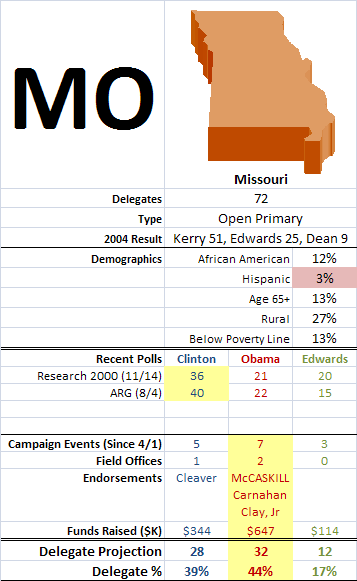
With Claire McCaskill's endorsement secured, everything looks good for Obama except for the polls. The most recent data we have -- still two months old -- is from Research 2000, and the 15-point gap that survey showed for Obama really isn't that bad for him considering that Clinton was polling about 25 points ahead nationally at that time. Edwards also stands to gain a few delegates here. Projected Delegate Count: Obama 32 (44%), Clinton 28 (39%), Edwards 12 (17%).
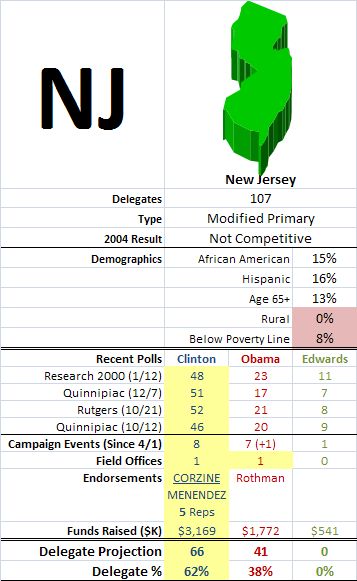
This is Clinton territory; it says something that the 23 points Obama pulled in the new Research 2000 poll is actually one of his stronger results. About the only things Obama has going for him are Bill Bradley's endorsement and the state's relatively large African-American population, but the instituional leaders are behind Clinton, and Obama's best-case scenario here is probably to limit the damage to about 15 points. Projected Delegate Count: Clinton 66 (62%), Obama 41 (38%).

Very little data to look at here -- nobody was polling the state while Bill Richardson was still in the race -- but the rural, improvished and Hispanic demographics should be quite favorable to Clinton, and it says something that this is one of the few Feb. 5 states where Obama has not opened a field office. I called this a toss-up before, but it should really be one of Clinton's better states; Obama might need a surprise endorsement from Richardson or Bingaman to be competitive. Projected Delegate Count: Clinton 15 (58%), Obama 11 (42%).
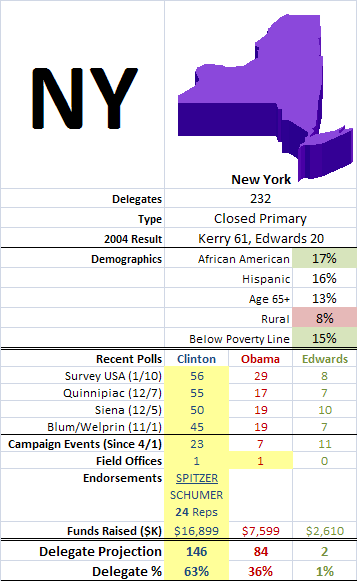
The funrdraising numbers aren't quite as disproportionate as they were are in Illinois or Arkansas, but as in New Jersey, a good result for Obama would mean keeping things within 15-20 points, probably by staying competitive in New York City. Since Obama has no surrogates here, that would probably require a big ad-buy, which might not be the best use of his resources. Projected Delegate Count: Clinton 146 (63%), Obama 84 (36%), Edwards 2 (1%).

I'd called North Dakota for Obama before, but look at the demographics -- it's the oldest, whitest, and most rural of any February 5 state. Obama does have a field office and Kent Conrad's endorsement, but this one leans Clinton. Projected Delegate Count: Clinton 7 (54%), Obama 6 (46%).
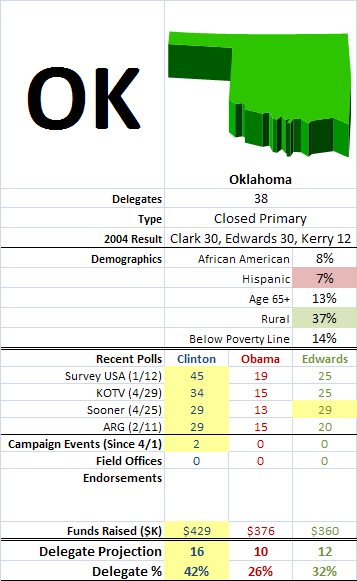
Quite possibly John Edwards' best state. He's consistently outpolled Obama (including in a new Survey USA poll), was quite competitive in fundraising, and it's one of four Super Tuesday states that he has committed to visiting (the others are Georiga, Missouri, and California). I don't see him beating Clinton, but he has some organization left over from 2004, and if he feels the need to go all-in somewhere, this might be the place. Projected Delegate Count: Clinton 16 (42%), Edwards 12 (32%), Obama 10 (26%).
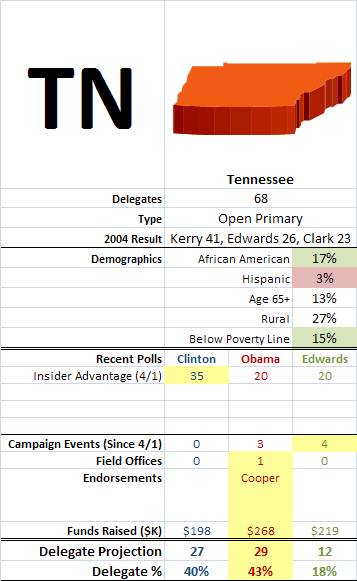
Tennesse is somewhat whiter than I'd realized, although since its white population tends conservative, the African-American population may make up a relatively large fraction of the Democratic voting base. With the open primary and more activity in the state to date, I rate Obama as having a slight edge. Projected Delegate Count: Obama 29 (43%), Clinton 27 (40%), Edwards 12 (18%).
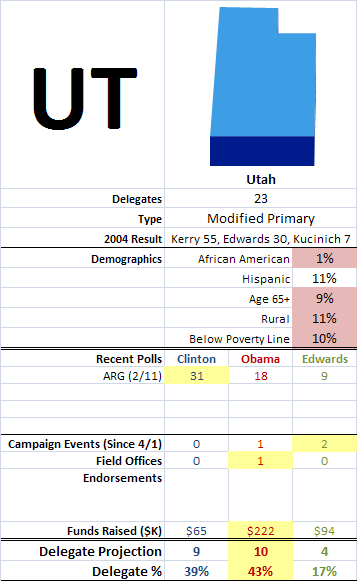
I really don't know what a Democrat looks like in Utah, but I see that the demographics lean really young, and that Obama did very well in fundraising, and that he has the only field office. Projected Delegate Count: Obama 10 (43%), Clinton 9 (39%), Edwards 4 (17%).
Summary Projection, Ordered by Delegation Size
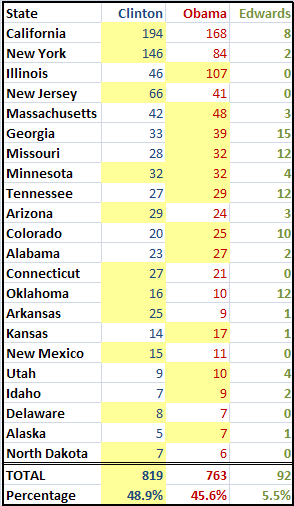
My best, gun-to-the-head projection right now is that Clinton retains some advantage on Super Tuesday, even though I expect the polls to close. However, I don't expect her to win by a large enough margin to end the race. On the contrary, we'd be in a rather messy, unprecedented situation. I'd expect the results of New York, Illinois and possibly New Jersey will be largely ignored because the results are foregone conclusions, and that Georgia and Alabama might be downplayed because those results would be perceived as redundant with what happened in South Carolina. But both sides would be able to proclaim some significant victories -- Clinton in California, Obama in places like Colorado, Missouri, and Massachusetts. We'd start to ask questions like whether John Edwards will drop out, and whether he'd cede his delegates to Obama; what happens if Obama wins the regular delegate count, but Clinton pulls ahead because of superdelegates, and what the party should do with the results of Florida and Michigan.
The next states after Super Tuesday tend to be relatively favorable for Obama...
February 9 -- Louisiana primary -- Large black population.
February 9 -- Nebraska caucus -- Has Ben Nelson's endorsement, might play similarly to Kansas.
February 9 -- Washington caucus -- Pac Northwest style liberalism is probably more compatible with Obama and Edwards than Clinton.
February 10 - Maine caucus -- This may be an exception as Clinton has polled strongly here, although Maine has a substantial independent/centrist streak.
February 12 -- Washington DC primary -- Heavily favors Obama.
February 12 -- Maryland primary -- He was up double-digits in the recent poll here.
February 12 -- Virginia primary -- Competitive; Tim Kaine was one of Obama's early backers.
February 19 -- Wisconsin primary -- Neighbors Illinois; has Jim Doyle's endorsement, has always polled pretty well here.
February 19 -- Hawaii caucus -- His native state.
...after that, the big date on the calendar is March 4, when both Ohio and Texas vote. Those look more like Clinton states, but Obama's hope would be to pick up enough momentum in places like Washington, Wisconsin and Virginia to slingshot to victory there.
My guess is that if one candidate wins both Ohio and Texas, they'll be declared the winner, and the superdelegates will begin to line up behind them. If we got a split verdict from those two states, on the other hand, we're probably headed to Pennsylvania on April 22 for a sort of national primary by proxy.
What would it take for a candidate to get a 'clean' victory on February 5th? For Clinton, it's pretty simple; she just needs to keep her national margins where they are now. If Obama can't win the Colorados and Missouris, he is probably in trouble, and he probably needs to shave a couple points off Clinton's national margins before he can win Colorado and Missouri.
For Obama, a win in California (coupled with the other wins that I've projected for him) might be pretty close to a victory condition. Because his expectations are lower in California, I suspect that a win there would mean more to him in terms of momentum.
Even under his absolute best-case scenario, I can't imagine John Edwards wrapping up the nomination on February 5th. He'd need to win three or four states like Oklahoma and Missouri, while beating expectations enough in the big states so as not to far too behind in the delegate count. If something like that happened, Edwards would emerge with huge momentum; he'd need to validate those results with wins in places like Virginia and Wisconsin, or else we'd likely be headed to a brokered convention.

























No comments:
Post a Comment